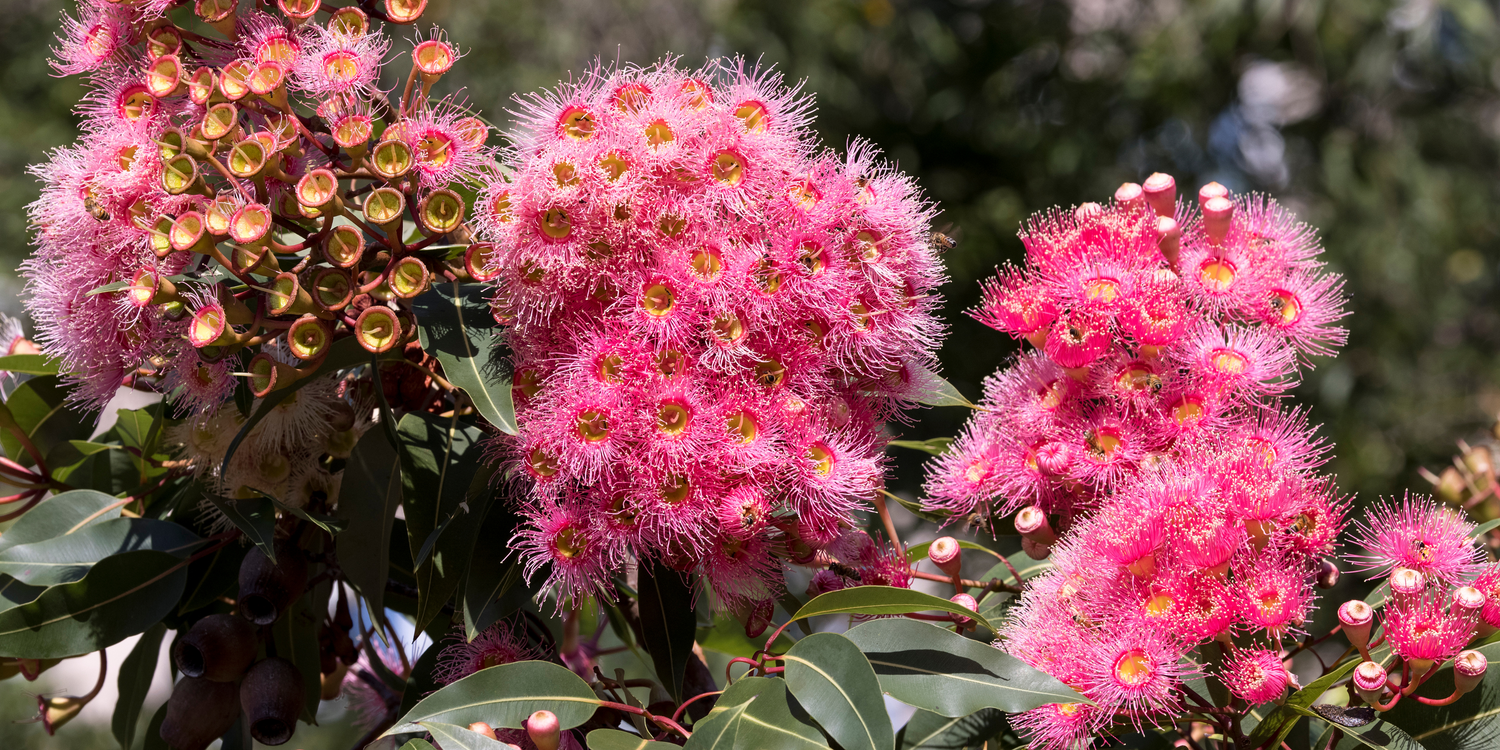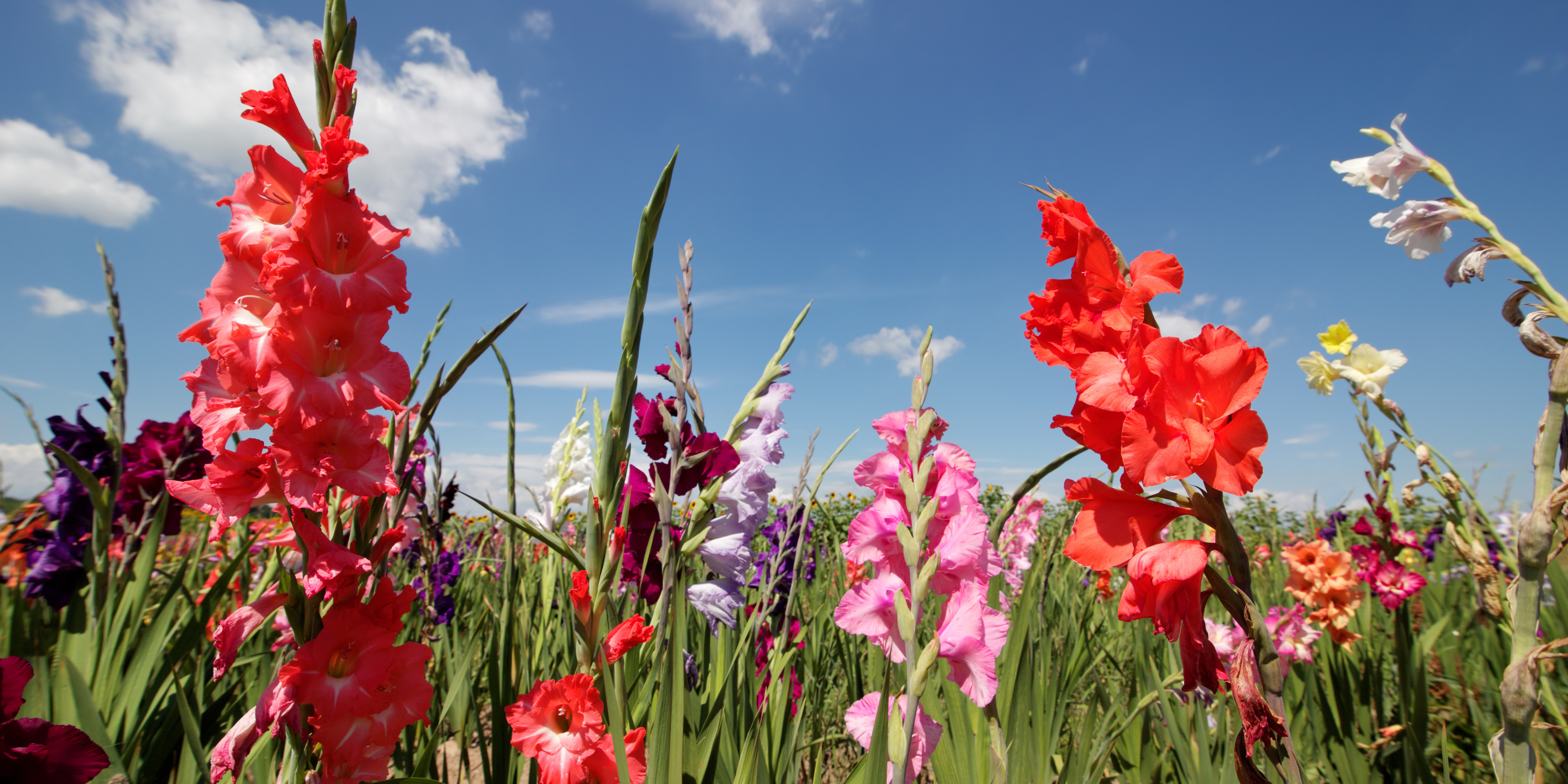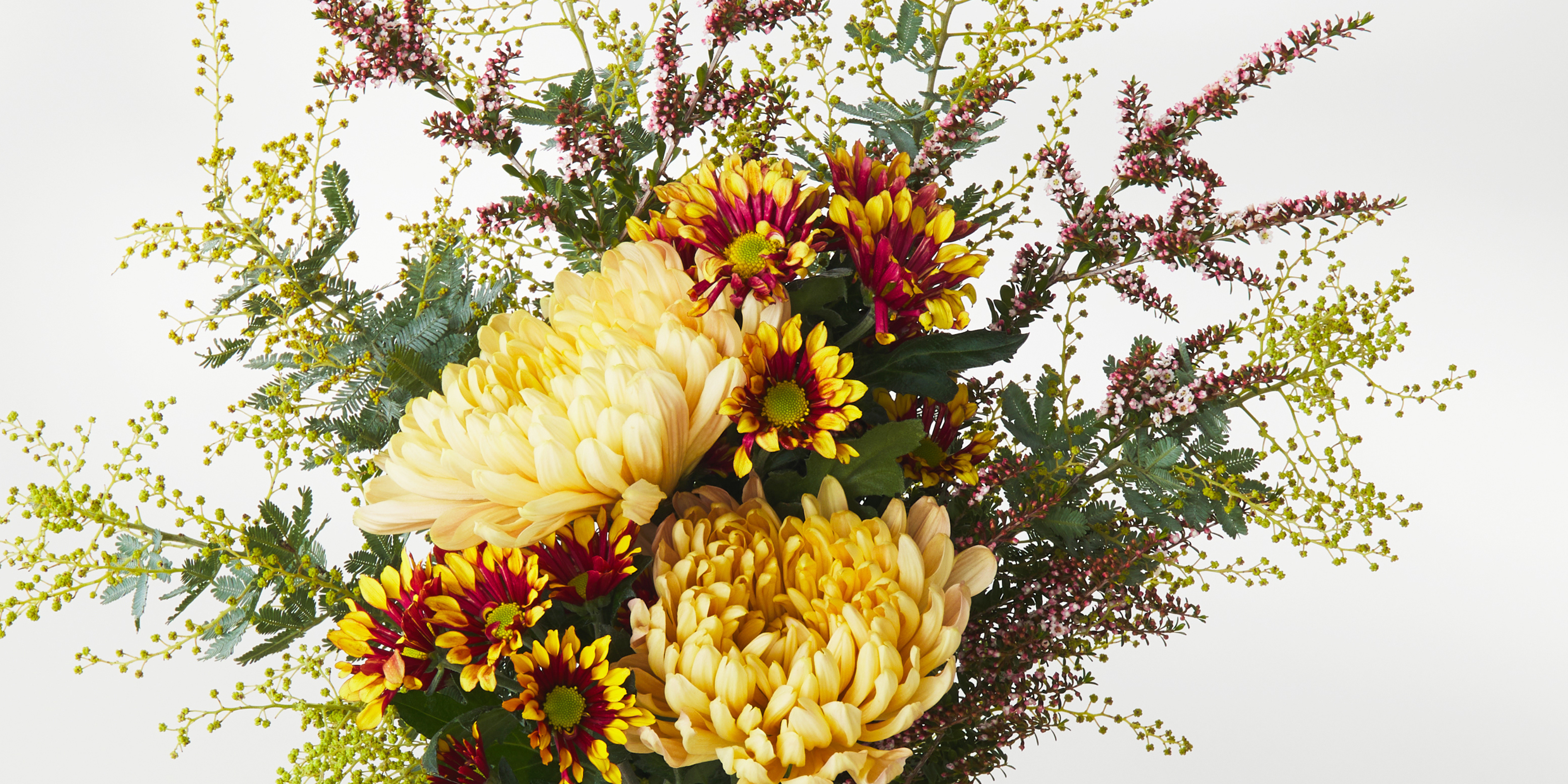Australia is home to some of the world's weirdest and most beautiful native plants in the world. Did you know there are actually over 20,000 species of Australian native plants? That's pretty impressive!
It also means we definitely won't be able to name them all in one article. But if you're looking for a quick list of some of the best Australian native plants, you've come to the right place.
Below, we'll give you an overview of some of the most popular species of Australian flora, some of which you might find growing in your own garden right now.
In the meantime, if you're looking to send a bunch of beautiful native flowers to someone you care about, be sure to check out our range of Australian natives and wildflowers.
Eucalyptus

Eucalyptus plants are a staple of the Australian landscape. There are over 700 different species of eucalypts, making them one of the most diverse groups of plants in the world, and the majority of them are native to Australia.
Eucalyptus trees, also called gum trees, are characterised by their tall, straight trunks and branches that are covered in a thick layer of bark. Several eucalyptus varieties are among the tallest trees in the world, some reaching upwards of 60m (or 200ft) in height! In fact, Eucalyptus regnans, which is native to Victoria and Tasmania, is the tallest flowering plant in the world.
Depending on the species, eucalyptus leaves can be long and narrow or short and round, and are usually a glossy or waxy green colour. They can also be blue-green, yellow-green, silver-green or even red. Eucalyptus leaves are also a popular cuisine for koalas.
Eucalyptus flowers are typically red, pink, white or yellow and are an important food source for nectar-feeding animals like birds, bats, bees and butterflies. Honey produced by bees that feed on eucalyptus flowers is thought to be some of the best in the world! Have you ever tried it?
Banksia

Banksias are one of the most iconic native Australian plants. They're a genus of around 170 species of shrubs and trees, belonging to the Proteaceae family, which also includes grevilleas, waratahs and bottlebrushes (which we'll get to soon), as well as the South African protea.
They can be found all around Australia's coast, with the greatest species diversity occurring in Western Australia. Banksia bushes and trees grow in some really challenging environments, usually in areas where the soil is sandy and nutrient-poor. Many species also rely on bushfires to release their seeds.
Banksias are easily identified thanks to their large, spiky flowers, which vary in size and shape, but are usually conical. The most common colour is yellow, but banksias can also be red, pink or even orange.
The flowers are inflorescent, meaning they're actually made up of many, many tiny flowers. Once cut, banksias last a long time in a vase, usually upwards of two or three weeks.
Nectar-rich banksias are an important food source for native birds, possums, bats and other animals, and for insects like bees and beetles, which eat the pollen.
Kangaroo Paw

Australia is full of unique and incredible native plants, but Anigozanthos, a.k.a kangaroo paw, may be one of the most unusual. Kangaroo paw is a genus of around 11 species of plants, all native to south-western Australia. Nowadays, they can be found all over the country, as they are a popular garden plant.
Kangaroo paw plants are characterised by their furry, tubular flowers, which look just like (as the name suggests) kangaroo paws! They generally flower in spring, but some species will also flower in summer or autumn. The flowers come in a range of colours, including red, green, yellow and black. Interestingly, the flower's colour is impacted by temperature, with more intense colours occurring in colder temperatures.
Nectar-rich kangaroo paws rely on birds and animals for pollination. When an animal eats the nectar, pollen sticks to its fur or feathers, and is then transferred to the next flower it visits.
Grevillea

Grevilleas can be found all across Australia, in every state and territory, except Tasmania. Like banksia, they belong to the Proteaceae family. They usually grow in woodlands or forests, but some species can also be found in heathland or swampy areas.
Also known as spider flowers, grevilleas have distinctive flowers with long, thin petals that can be quite brush or spider-like. These flowers are often brightly coloured, in shades of yellow, pink and red.
Some grevilleas flower all year round, providing a splash of colour to our gardens in winter, and food for pollinators at times when other food sources are scarce. The nectar produced by grevilleas is an important food source for many animals, especially honeyeater birds. Planting grevilleas in your garden is a sure-fire way of attracting birds, bees and butterflies.
Wattle

Acacia trees are found all around the world. There are about 1,300 species of shrubs and trees in the genus, and nearly 1,000 of these are native to Australia. But in Australia, acacia trees are known by another name... wattle trees!
As you might expect from such a large group of plants, wattles are found in all sorts of different habitats across Australia, particularly in semi-arid inland areas. Acacia forests are actually Australia's second most common type of forest, after eucalyptus forests.
Wattle plants vary in size and appearance; some species are low-spreading shrubs while others can grow to be imposing, 30m tall trees. Like banksia, wattle flowers are inflorescent, meaning they're actually made up of lots of tiny little flowers. Many varieties have a beautiful, fresh, earthy scent, similar to aniseed.
When you think of wattle flowers, you probably immediately think of those iconic clusters of fluffy, bright yellow globules. But not all wattle flowers are globular; some are cylindrical.
And not all wattle flowers are yellow! Acacia purpureopetala is endemic to north Queensland, and is the only variety in the world to produce pink-purple flowers. Acacia leprosa, also called cinnamon wattle, produces red flowers. And Acacia linifolia, also known as flax wattle or (spoiler alert) white wattle, grows in eastern NSW and produces white flowers.
Wattle is undoubtedly one of Australia's most iconic and important native plants. So much so that Acacia pycnantha, the Golden Wattle, has been the official floral emblem of Australia since 1988, and each year on September 1st Australia celebrates National Wattle Day!
Eremophila

This one is probably slightly less known than the other Australian native plants we've listed above. Eremophilas are a group of over 200 species of Australian native shrubs and trees. Today they're found all over mainland Australia, particularly in arid or semi-arid regions.
Eremophilas tend to be small to medium-sized shrubs, and are often covered in colourful, tubular flowers. These flowers can be pink, red, yellow, white or even purple, and they bloom for a long time, often from winter into summer. They're resilient plants, capable of surviving drought, frost and fire, but they don't do well in humid conditions.
Eremophilas are also known as "poverty bushes", because of their tendency to grow in poor conditions. They're also sometimes called "emu bushes", because they're a popular food source for emus!
Bottlebrush

Callistemons are a group of around 30 species of native shrubs and trees. They're commonly called "bottlebrushes" because of their resemblance to the brushes we use to clean bottles—they're cylindrical, and covered in lots of soft, brushlike filaments.
Bottlebrushes prefer warm, temperate and moist conditions, but will grow in all but the driest areas. They're most commonly found along the eastern coastline of Australia, from far north Queensland to south-eastern Victoria, and in a small area of south-western Australia.
The flowers are often a brilliant, vibrant shade of red, but they can also be pink, cream, yellow and green. They add a stunning pop of colour to any garden when they bloom in summer and autumn, attracting lots of nectar-feeding birds, bees and butterflies.
Plus, bottlebrushes are almost impossible to kill—just another reason they're an appealing garden plant!
Boronia

Boronias are best known for their stunning, star-shaped flowers, which bloom from spring to summer in shades of pink, red, white and yellow. They're part of the Rutaceae family, a.k.a the citrus family, and the flowers and foliage are filled with fragrant essential oils.
Their perfume is particularly intense in the evening, when they release their scent to attract night-flying insects, like moths. Depending on the type of boronia, this scent can either be heavenly or rather unpleasant!
There are more than 100 species of boronia, and almost all of them are native to Australia. They grow best in warm coastal regions, but hate moist and humid conditions, as they are prone to root rot.
Boronias are definitely not the easiest plants to grow in your home garden, but they are among the most beautiful and most fragrant of Australian native flora.
Macadamia

Macadamia trees are native to parts of New South Wales and Queensland, where they grow in warm, humid conditions.
The flowers, which can be creamy or pinkish-purple in colour depending on the species, appear in spring and early summer, followed by the fruits. These are the macadamia nuts that we all know and love! The nuts mature from September to March, and are encased in a thick, hard shell.
There are just four species of trees in the Macadamia genus, and only two of these produce nuts we can actually eat: Macadamia integrifolia (Queensland Nut) and Macadamia tetraphylla (Rough-shelled Macadamia). All four species are either vulnerable or endangered.
Historically, macadamia nuts were an important food source for Indigenous peoples living in the areas the trees once grew naturally. Nowadays, they're grown more in commercial plantations than in the wild—they're one of the most valuable crops in Australia, in fact. Outside of Australia, Hawaii and South Africa are some of the largest producers of macadamias in the world.
Macadamias are relatively easy to grow at home, as long as you can provide them with the warm, humid conditions they need. If you're lucky enough to have a macadamia tree in your garden, you can enjoy the flowers, the nuts and the shade it provides!
Telopea

Telopeas, or waratahs, are large shrubs and small trees, endemic to south-eastern Australia. The name 'telopea' comes from the Greek word for 'seen from afar', referring to the plant's large, showy flowers.
The best-known species is Telopea speciosissima, which is the state floral emblem of NSW. It even almost became the floral emblem of Australia, before it was beaten out by wattle. In the springtime, this waratah species produces huge, bright red flower heads. These are probably the flowers you think of when you picture waratahs. Interestingly, the name "waratah" was first applied to this particular species by the Eora Indigenous peoples, who originally inhabited the Sydney area, before it was more generally applied to other Telopea species.
In addition to the iconic red, some waratah varieties may be pink, yellow or even white. They bloom in spring and early summer, and are an important source of food for nectar-feeding animals, like honeyeater birds and pygmy possums.
After the flowers fade, they are replaced by woody seed capsules, which contain winged seeds that are spread by the wind.
Thryptomene

Thryptomene is a genus of about 40 species of Australian native shrubs. They're found all across the country, but primarily in Western Australia. They produce dozens of tiny flowers, which are usually white or pink and bloom in clusters from spring to summer.
Thryptomene is a low-maintenance plant that is relatively easy to grow. It's very hardy and resilient, able to tolerate most soil types and resist drought conditions. Thryptomene is a great choice for gardens of all sizes, as it can be pruned to maintain a compact shape.
Chamelaucium

Chamelaucium, also known as waxflower, is a genus of shrubs native to Western Australia. The most famous species is the Geraldton wax, which is the state floral emblem of Western Australia.
The shrubs vary in size from 30cm to 3m tall and have slender stems with small leaves. The flowers bloom from late winter into early spring. These flowers are small but stunning, ranging in colour from white to shades of pink, purple and red.
Once cut, waxflowers can last up to three weeks in a vase, making them a popular addition to floral arrangements.
Dampiera

Dampiera is found in all states and territories except Tasmania, but is most common in Western Australia. Dampiera plants flower from spring to summer, producing striking bright purple, violet, pink and (rarely) white flowers.
Hakea

Hakea plants are found in all Australian states, but have the greatest diversity in Western Australia. The plants flower in autumn and winter.
Like waratahs, banksias, grivelleas and other plants in the Proteaceae family, hakeas are characterised by their unusual flowers. For example, Hakea laurina, also known as the pin-cushion hakea, produces red-pink globular flowers that are covered in contrasting white styles, resembling a pin-cushion.
Hakeas are drought tolerant and thrive in a range of conditions. They grow so readily that they've actually become weedy in some parts of the country, invading the natural habitat of local vegetation.
Pycnosorus

No, it's not a dinosaur. It's a type of plant! The six species of Pycnosorus are all native to Australia, and can be found across the Australian mainland. Belonging to the Asteraceae family, the same family as sunflowers and gerberas, the flowers are more commonly known as billy buttons.
Billy buttons are easily recognisable thanks to their spherical heads, which are covered in dozens of small, bright yellow, daisy-like flowers. They have a long flowering season, spanning across spring and summer.
The plant grows well in moist and swampy areas, but will tolerate dry conditions and frost as well. They grow from an underground rhizome, so if the plant dies off above ground it will eventually sprout anew.
***
So there you have it: a quick and easy yet still fairly comprehensive guide to Australian native plants! Whether you're looking to add some variety to your garden, or you're just curious about the plants that grow in this country, we hope this article has been helpful.



